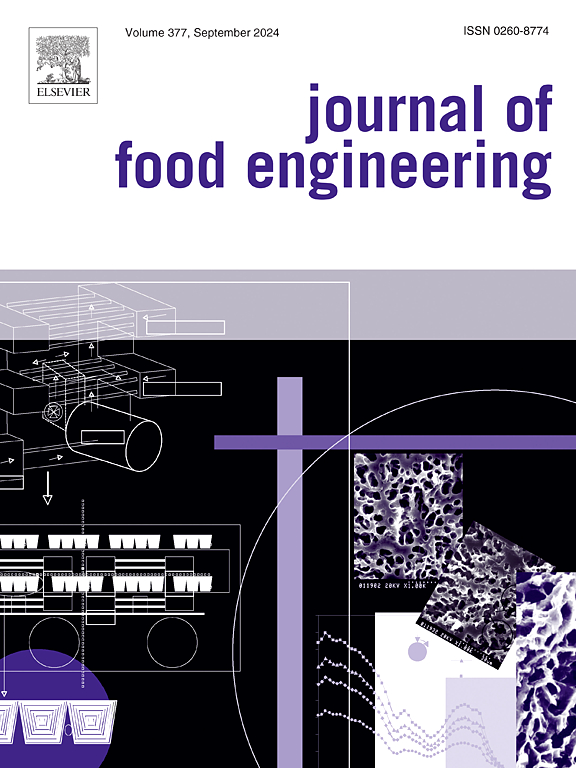Monitoring the texture of high-moisture extrudates in the cooling die of an extruder using near-infrared spectroscopy
IF 5.8
2区 农林科学
Q1 ENGINEERING, CHEMICAL
引用次数: 0
Abstract
High-moisture extrusion processing (HMEP) is used to produce high-moisture extrudates (HME) with fibrous textures that mimic animal meat. However, many factors affect the final product, and industries require in-line control tools to monitor and optimise the process. This study aims to evaluate the feasibility of using near-infrared spectroscopy (NIRS) to monitor HMEP in the cooling die of an extruder through the prediction of the textural properties of the final product. Different strategies to minimise the temperature effects over the spectra and different modelling approaches were evaluated. To do so, NIR spectra were acquired in the cooling die of the extruder during HMEP at different cooling die temperatures (10–30 °C) and flow rates (10.0, 12.5, 16, 19.5, and 22.0 g/min). Then, the moisture content and textural properties of the final HME were determined physicochemically. Various correction techniques were used to minimise the effects of temperature on the spectra and improve the in-line prediction accuracy of the extrudates' textural properties. Results showed that, with adequate preprocessing, the textural properties could be estimated using both partial least squares regression (PLSR) and principal component regression. Using PLSR models, the lowest predictive errors obtained were 0.87 N for transversal cut force, 9.15 N for hardness, and 7.90·10−3 for springiness. However, the data proved to be insufficient to train a convolutional neural network properly. Although more experimental work is needed, NIRS and chemometric techniques demonstrate potential for monitoring HMEP in the cooling die, enabling in-line optimisation of this process.
利用近红外光谱技术监测挤出机冷却模内高水分挤出物的织构
高水分挤压加工(HMEP)用于生产具有类似动物肉的纤维纹理的高水分挤出物(HME)。然而,影响最终产品的因素很多,行业需要在线控制工具来监控和优化过程。本研究旨在通过预测最终产品的纹理特性,评估使用近红外光谱(NIRS)监测挤出机冷却模具中HMEP的可行性。不同的策略,以尽量减少温度对光谱的影响和不同的建模方法进行了评估。为此,在不同冷却模温度(10-30°C)和流速(10.0、12.5、16、19.5和22.0 g/min)下,在HMEP过程中,在挤出机的冷却模中获得近红外光谱。然后,用物理化学方法测定了最终HME的含水率和织构性能。使用了各种校正技术来最小化温度对光谱的影响,并提高了挤出物纹理特性的在线预测精度。结果表明,通过适当的预处理,可以使用偏最小二乘回归和主成分回归来估计织物的纹理特性。使用PLSR模型,获得的最小预测误差为横向切削力0.87 N,硬度9.15 N,弹性7.90·10−3。然而,事实证明,这些数据不足以正确训练卷积神经网络。虽然需要更多的实验工作,近红外光谱和化学计量技术证明了在冷却模具中监测HMEP的潜力,使这一过程的在线优化成为可能。
本文章由计算机程序翻译,如有差异,请以英文原文为准。
求助全文
约1分钟内获得全文
求助全文
来源期刊

Journal of Food Engineering
工程技术-工程:化工
CiteScore
11.80
自引率
5.50%
发文量
275
审稿时长
24 days
期刊介绍:
The journal publishes original research and review papers on any subject at the interface between food and engineering, particularly those of relevance to industry, including:
Engineering properties of foods, food physics and physical chemistry; processing, measurement, control, packaging, storage and distribution; engineering aspects of the design and production of novel foods and of food service and catering; design and operation of food processes, plant and equipment; economics of food engineering, including the economics of alternative processes.
Accounts of food engineering achievements are of particular value.
 求助内容:
求助内容: 应助结果提醒方式:
应助结果提醒方式:


